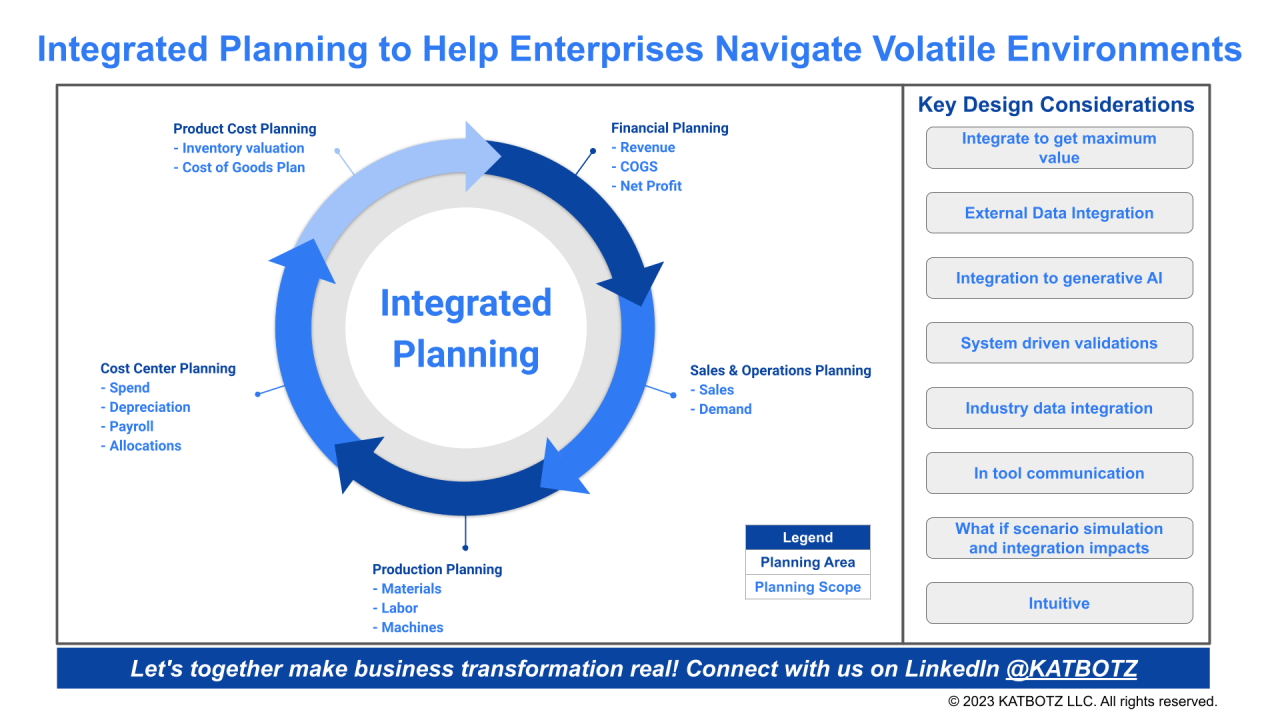Overview
Business teams need to work cohesively to achieve objectives that are laid out by the leaders. Enterprises operate in dynamic environments where multiple variables influence micro and macro outcomes. How do we then plan our businesses in such volatile environments to operate like a well oiled machine?
The latest innovations are allowing more seamless integrations and providing business users real time integrated information to see the effects of plan changes that are being made in other areas of the business/external factors. We can instantly answer questions like:
- What happens to my bottomline if I change my product mix? Sales and Operations plan can be tightly integrated to Financial Plan. Not only at the revenue level but also at the cost level
- What is the effect of change in interest/exchange rate on my bottomline?
- How will a terms of payment change my working capital projections?
We can significantly improve planning accuracy by integrating plans from different areas. By doing this, we can see the ripple effect of each decision and how it impacts the overall plan in real time. Additionally, complementing enterprise data with external data sources and integrations can make the plan more intelligent, taking into account variables such as exchange rates.
Note: Consider relevant drivers while designing integrated plans.
There are multiple ways we can use the building blocks, however I would like to take one example with key aspects to help you understand integrated planning between sales, operations and finance. The scenario below talks about integrated planning with SAP products and external integrations for a manufacturing company.
Prerequisite
Configuration, system setup and Clean Master data setup in SAP S/4HANA, SAP Integrated Business Planning, SAP Analytics for Cloud and other data sources e.g. Material Master, Bill of Materials, Routers, Purchase Info Records, Finance Master Data, external data.
Integrated Plan Components
SAP Analytics for Cloud (SAC): Financial goals are set for the enterprise, based on which the first cut plan is created in dollar terms.
SAP Integrated Business Planning for Supply Chain: Sales and Operations Planning (S&OP) helps take this plan to the next level by distributing dollars at the product level to create a sales and demand plan.
SAP Integrated Business Planning for Supply Chain -> SAP S/4HANA Production Planning: Demand plan from S&OP is then fed into manufacturing planning to come up with materials and routing-related planning/hours per work center for activity types i.e. labor, machine, overheads.
SAP S/4HANA Cost Center Accounting:
- Plan Spend in cost centers can be interfaced from SAC plan or input directly in S/4HANA. Plan spend and hours are used to come up with activity rates for allocation to products in planning product costs.
- SAP S/4HANA – Cost Center Accounting, Asset Accounting, HR PlanningCost center data is populated with depreciation costs automatically, HR payroll cost, and other expenses in cost centers that can be integrated with the overall plan
- Planned Allocations within cost centers e.g. service cost centers to manufacturing line cost centers
- Simulated product plan from production planning is then fed into cost centers with hours per work center/cost center combination to calculate activity rates for absorption of costs from cost centers.
Note: Instead of using activity rates we can also use template allocation for more precise overhead allocation from cost centers/business processes to product cost. Typically used for sterilization and freight as cost is attributable based on units produced.
SAP S/4HANA Product Costing: The standard cost rollup helps bring it together in SAP S/4HANA from a product costing point of view e.g. Material, labor & overhead costs are rolled up. Cost rollup considers all relevant costs to come up with the group, legal, profit center valuation of inventory.
SAP S/4HANA Product Costing and SAC:The standard cost data can then be used for planned Cost of Goods sold calculation.
External data source integration e.g. exchange rates, interest rates
AI, Machine Learning and Automation use cases:
Few use cases for automation, AI and Machine Learning in this space:
- Seamless integration between plans in different departments
- Realtime tools for interactions among planners and leaders that embedded with generative AI
- System driven validations and suggestions for corrective action
- Automated comparison to publicly available industry data/benchmarks
Benefits
Planning is a key part of the business strategy. Here are some potential benefits of integrated planning for enterprise customers:
- Improved accuracy: By integrating systems and making plans more connected, businesses can get a better understanding of the ripple effect of each decision, leading to more accurate planning.
- Better decision-making: Integrated planning allows businesses to make informed decisions based on real-time data, external data sources, and integrations, leading to better outcomes.
- Increased efficiency: Integrating systems and making plans more connected can help streamline processes and reduce duplication of efforts, leading to greater efficiency.
- Improved collaboration: Integrated planning can help break down silos within organizations, allowing different departments and teams to work together more effectively towards a common goal.
- Enhanced agility: By having real-time data and insights, businesses can quickly adapt to changes in the market, enabling them to be more agile in their planning and decision-making.
Conclusion
Integrated planning can provide businesses with a comprehensive overview of their operations, enabling them to make well-informed decisions based on accurate, real-time data. Through integrated planning, teams can quickly iterate results and gain a better understanding of the related impact of any changes. While it may require some change management to adapt to new systems and processes, the long-term benefits are significant. Planning teams will have the ability to make more accurate predictions, leading to improved outcomes and increased business success.
Call to Action
I am sure that you all have many more ideas on this topic. Would love to hear your challenges, thoughts and ideas. Let us solve business problems together, connect with us KATBOTZ LLC.
By Ashish Katyayan

